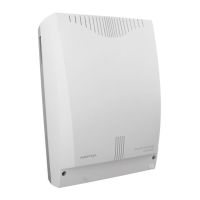Ascotel IntelliGate 2025/2045/2065
330 Call Routing Part 2
• The PBX activates PARE or CD at the public network provider.
• The network provider takes charge of the Call Forwarding Unconditional; the
2 B channels are freed.
• Subscriber C is called. He is presented with subscriber A's phone number and
the redirecting information by way of CLIP. At the same time the redirecting
information is also transmitted back to subscriber A (see "Display for Call For-
warding Unconditional", page 191).
Call charges:
• Subscriber pays the call charges up to the call forwarding location in the net-
work.
• Subscriber B pays the call charges from the call forwarding location to
subscriber C.
Call Forwarding Functions Supported
The system routes the following call forwarding to the exchange:
• Call Forwarding Unconditional (CFU)
• Call Forwarding Busy (CFB)
• Call Forwarding on No Reply (CFNR)
• Call Deflection (CD) by a subscriber (forwarding a call during the ringing phase)
With all call forwarding functions the call only continues ringing at subscriber C
once it has been forwarded to the exchange.
Requirements
Call forwarding to the exchange is subject to the following requirements:
• ISDN network interfaces T/T2 (QSIG and analogue are not supported).
• In point-to-point operation the supplementary service partial rerouting must be
available (subscription may be required).
• In point-to-multipoint operation the supplementary service call deflection must
be available (subscription may be required).
• Subscriber B must be defined as a "Subscriber"-type individual destination in
the call distribution element used by subscriber A to make his call.
• The relevant authorizations must be enabled.
• The call number of the external call forwarding destination must not be entered
as an analysable digit sequence in an LCR table if LCR is active.

